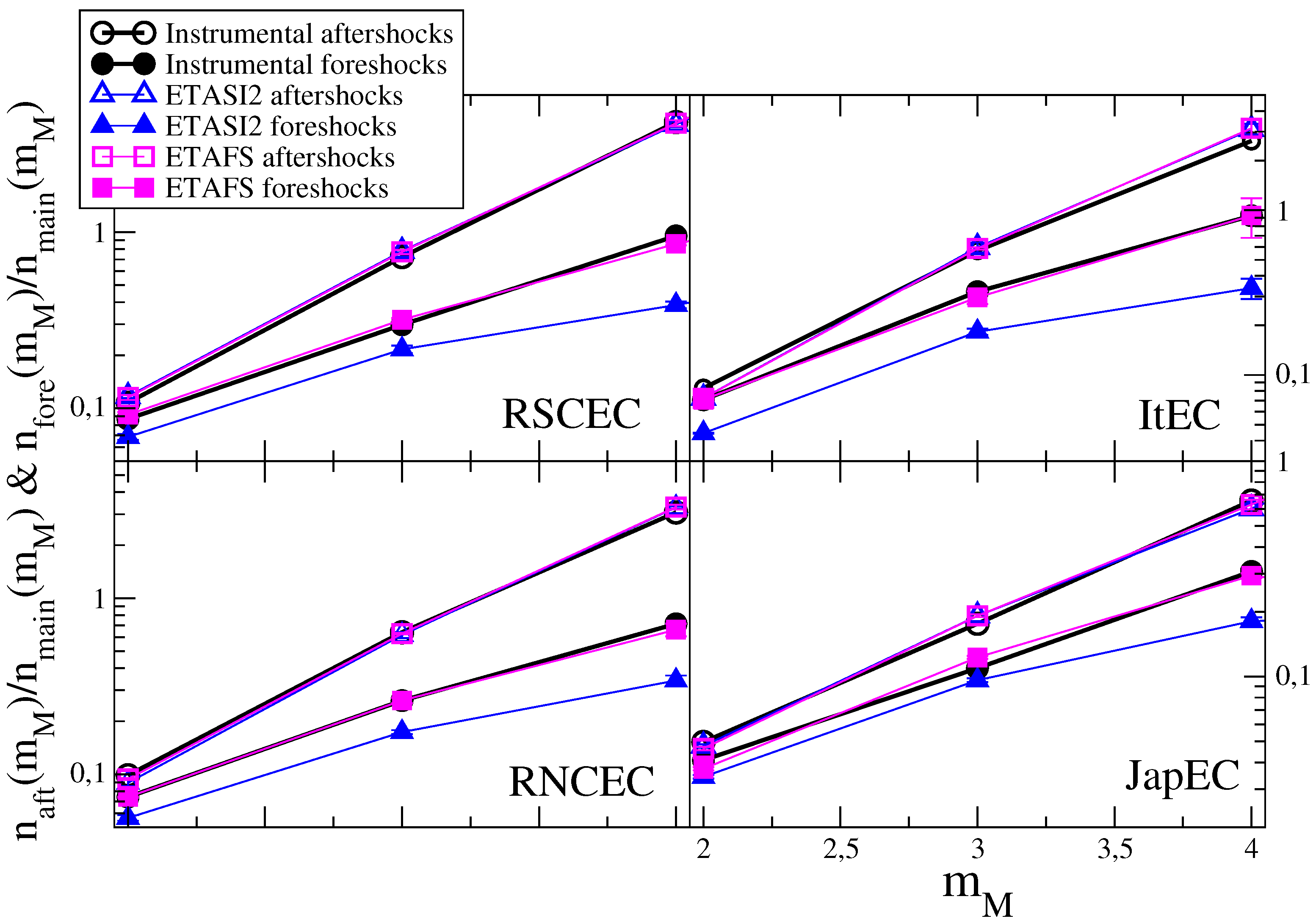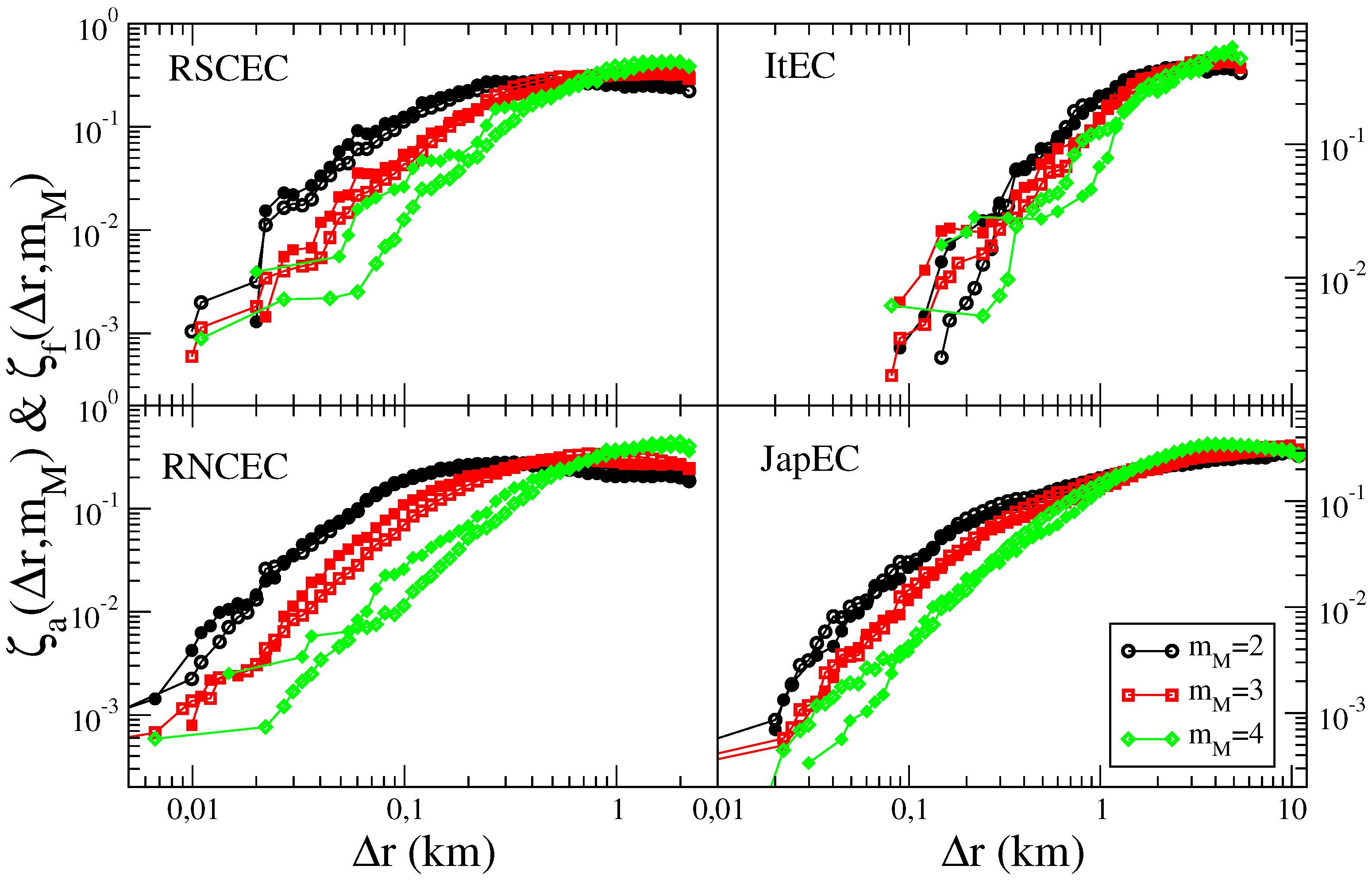The Relevance of Foreshocks in Earthquake Triggering: A Statistical Study
Abstract
:1. Introduction
- A1: The number of aftershocks depends on the mainshock magnitude according to the productivity law ;
- A2: The aftershock number decays as function of the time from the mainshock, consistently with the Omori law with ;
- A3: The distribution of epicentral distances between mainshock and aftershocks clearly depends on the mainshock magnitude .
- F1: The average foreshock number in instrumental catalogs is significantly larger than the one expected according to the ETAS model;
- F2: The organization in space of instrumental foreshocks exhibit a dependence on the mainshock magnitude not predicted by the ETAS model.
2. Epidemic Models for Aftershocks and Foreshock Occurrence
2.1. The ETAS Model
2.2. The ETAS Incomplete Catalog
2.3. The ETAFS Model
3. Results in the Instrumental Catalogs
3.1. Data Sets and the Definitions of Mainshocks, Aftershocks and Foreshocks
3.2. The Aftershock and Foreshock Number
3.3. Aftershock and Foreshock Spatial Distribution
4. Results in Numerical Catalogs
4.1. Results in the ETAS Catalog
The Aftershock and Foreshock Number in the ETAS Catalog
4.2. Aftershock and Foreshock Spatial Distribution in the ETAS Catalog
4.3. Results in the ETASI2 Catalog
4.4. Results in ETAFS Catalogs
5. Conclusions
Author Contributions
Funding
Acknowledgments
Conflicts of Interest
References
- Ogata, Y. Statistical Models for Earthquake Occurrences and Residual Analysis for Point Processes. J. Am. Stat. Assoc. 1988, 83, 9–27. [Google Scholar] [CrossRef]
- Ogata, Y. Space-time Point-process Models for Earthquake Occurrences. Ann. Inst. Stat. Math. 1988, 50, 379–402. [Google Scholar] [CrossRef]
- Ogata, Y. A Monte Carlo method for high dimensional integration. Numer. Math. 1989, 55, 137–157. [Google Scholar] [CrossRef]
- Huang, Q.; Gerstenberger, M.; Zhuang, J. Current Challenges in Statistical Seismology. Pure Appl. Geophys. 2016, 173, 1–3. [Google Scholar] [CrossRef] [Green Version]
- Corral, A. Long-Term Clustering, Scaling, and Universality in the Temporal Occurrence of Earthquakes. Phys. Rev. Lett. 2004, 92, 108501. [Google Scholar] [CrossRef] [PubMed]
- Corral, A. Renormalization-Group Transformations and Correlations of Seismicity. Phys. Rev. Lett. 2005, 95, 028501. [Google Scholar] [CrossRef] [PubMed]
- Corral, A. Scaling and universality in the dynamics of seismic occurrence and beyond. In Acoustic Emission and Critical Phenomena; CRC Press: Boca Raton, FL, USA, 2008; pp. 225–244. [Google Scholar]
- Bottiglieri, M.; de Arcangelis, L.; Godano, C.; Lippiello, E. Multiple-Time Scaling and Universal Behavior of the Earthquake Interevent Time Distribution. Phys. Rev. Lett. 2010, 104, 158501. [Google Scholar] [CrossRef] [PubMed]
- Lippiello, E.; Corral, A.; Bottiglieri, M.; Godano, C.; de Arcangelis, L. Scaling behavior of the earthquake intertime distribution: Influence of large shocks and time scales in the Omori law. Phys. Rev. E 2012, 86, 066119. [Google Scholar] [CrossRef] [PubMed]
- Varotsos, P.A.; Sarlis, N.V.; Skordas, E.S.; Tanaka, H.K.; Lazaridou, M.S. Attempt to distinguish long-range temporal correlations from the statistics of the increments by natural time analysis. Phys. Rev. E 2006, 74, 021123. [Google Scholar] [CrossRef]
- Sarlis, N.V.; Skordas, E.S.; Varotsos, P.A. Nonextensivity and natural time: The case of seismicity. Phys. Rev. E 2010, 82, 021110. [Google Scholar] [CrossRef]
- de Arcangelis, L.; Godano, C.; Grasso, J.R.; Lippiello, E. Statistical physics approach to earthquake occurrence and forecasting. Phys. Rep. 2016, 628, 1–91. [Google Scholar] [CrossRef]
- Ohnaka, M. Earthquake source nucleation: A physical model for short-term precursors. Tectonophysics 1992, 211, 149–178. [Google Scholar] [CrossRef]
- Ohnaka, M. Critical Size of the Nucleation Zone of Earthquake Rupture Inferred from Immediate Foreshock Activity. J. Phys. Earth 1993, 41, 45–56. [Google Scholar] [CrossRef]
- Dodge, D.A.; Beroza, G.C.; Ellsworth, W.L. Detailed observations of California foreshock sequences: Implications for the earthquake initiation process. J. Geophys. Res. Solid Earth 1996, 101, 22371–22392. [Google Scholar] [CrossRef] [Green Version]
- Brodsky, E.E. The spatial density of foreshocks. Geophys. Res. Lett. 2011, 38, L10305. [Google Scholar] [CrossRef]
- Lippiello, E.; Marzocchi, W.; de Arcangelis, L.; Godano, C. Spatial organization of foreshocks as a tool to forecast large earthquakes. Sci. Rep. 2012, 2, 846. [Google Scholar] [CrossRef] [PubMed]
- Shearer, P.M. Self-similar earthquake triggering, Bath’s law, and foreshock/aftershock magnitudes: Simulations, theory, and results for Southern California. J. Geophys. Res.-Solid Earth 2012, 117. [Google Scholar] [CrossRef]
- Shearer, P.M. Space-time clustering of seismicity in California and the distance dependence of earthquake triggering. J. Geophys. Res. Solid Earth 2012, 117. [Google Scholar] [CrossRef] [Green Version]
- Hainzl, S. Comment on “Self-similar earthquake triggering, Båth’s law, and foreshock/aftershock magnitudes: Simulations, theory, and results for southern California” by P. M. Shearer. J. Geophys. Res. Solid Earth 2013, 118, 1188–1191. [Google Scholar] [CrossRef]
- Shearer, P.M. Reply to comment by S. Hainzl on “Self-similar earthquake triggering, Båth’s Law, and foreshock/aftershock magnitudes: Simulations, theory and results for southern California”. J. Geophys. Res. Solid Earth 2013, 118, 1192. [Google Scholar] [CrossRef]
- Bouchon, M.; Durand, V.; Marsan, D.; Karabulut, H.; Schmittbuhl, J. The long precursory phase of most large interplate earthquakes. Nat. Geosci. 2013, 6, 299–302. [Google Scholar] [CrossRef]
- Mignan, A. The debate on the prognostic value of earthquake foreshocks: A meta-analysis. Sci. Rep. 2014, 4, 4099–4103. [Google Scholar] [CrossRef] [PubMed]
- Chen, X.W.; Shearer, P.M. California foreshock sequences suggest aseismic triggering process. Geophys. Res. Lett. 2013, 40, 2602–2607. [Google Scholar] [CrossRef] [Green Version]
- Brodsky, E.E.; Lay, T. Recognizing Foreshocks from the 1 April 2014 Chile Earthquake. Science 2014, 344, 700–702. [Google Scholar] [CrossRef] [Green Version]
- Ogata, Y.; Katsura, K. Comparing foreshock characteristics and foreshock forecasting in observed and simulated earthquake catalogs. J. Geophys. Res. Solid Earth 2014, 119, 8457–8477. [Google Scholar] [CrossRef] [Green Version]
- Felzer, K.R.; Page, M.T.; Michael, A.J. Artificial seismic acceleration. Nat. Geosci. 2015, 8, 82–83. [Google Scholar] [CrossRef]
- Bouchon, M.; Marsan, D. Reply to ‘Artificial seismic acceleration’. Nat. Geosci. 2015, 8, 83. [Google Scholar] [CrossRef]
- Lippiello, E.; Giacco, F.; Marzocchi, W.; Godano, C.; Arcangelis, L.D. Statistical Features of Foreshocks in Instrumental and ETAS Catalogs. Pure Appl. Geophys. 2017, 1–19. [Google Scholar] [CrossRef]
- Seif, S.; Zechar, J.D.; Mignan, A.; Nandan, S.; Wiemer, S. Foreshocks and Their Potential Deviation from General SeismicityForeshocks and Their Potential Deviation from General Seismicity. Bull. Seismol. Soc. Am. 2018, 109. [Google Scholar] [CrossRef]
- Kagan, Y.Y. Short-Term Properties of Earthquake Catalogs and Models of Earthquake Source. Bull. Seismol. Soc. Am. 2004, 94, 1207–1228. [Google Scholar] [CrossRef]
- Helmstetter, A.; Kagan, Y.Y.; Jackson, D.D. Comparison of Short-Term and Time-Independent Earthquake Forecast Models for Southern California. Bull. Seismol. Soc. Am. 2006, 96, 90–106. [Google Scholar] [CrossRef] [Green Version]
- Enescu, B.; Mori, J.; Miyazawa, M. Quantifying early aftershock activity of the 2004 mid-Niigata Prefecture earthquake (Mw6.6). J. Geophys. Res. Solid Earth 2007, 112, B04310. [Google Scholar] [CrossRef]
- Peng, Z.; Vidale, J.E.; Ishii, M.; Helmstetter, A. Seismicity rate immediately before and after main shock rupture from high-frequency waveforms in Japan. J. Geophys. Res. Solid Earth 2007, 112, B03306. [Google Scholar] [CrossRef]
- Peng, Z.; Zhao, P. Migration of early aftershocks following the 2004 Parkfield earthquake. Nat. Geosci. 2009, 2, 877–881. [Google Scholar] [CrossRef]
- Omi, T.; Ogata, Y.; Hirata, Y.; Aihara, K. Forecasting large aftershocks within one day after the main shock. Sci. Rep. 2013, 3, 2218. [Google Scholar] [CrossRef] [PubMed]
- Lippiello, E.; Cirillo, A.; Godano, G.; Papadimitriou, E.; Karakostas, V. Real-time forecast of aftershocks from a single seismic station signal. Geophys. Res. Lett. 2016, 43, 6252–6258. [Google Scholar] [CrossRef]
- Hainzl, S. Apparent triggering function of aftershocks resulting from rate-dependent incompleteness of earthquake catalogs. J. Geophys. Res. Solid Earth 2016, 121, 6499–6509. [Google Scholar] [CrossRef] [Green Version]
- Hainzl, S. Rate-Dependent Incompleteness of Earthquake Catalogs. Seismol. Res. Lett. 2016, 87, 337–344. [Google Scholar] [CrossRef]
- de Arcangelis, L.; Godano, C.; Lippiello, E. The overlap of aftershock coda-waves and short-term post seismic forecasting. J. Geophys. Res. Solid Earth 2018, 123, 5661–5674. [Google Scholar] [CrossRef]
- Shcherbakov, R.; Yakovlev, G.; Turcotte, D.L.; Rundle, J.B. Model for the Distribution of Aftershock Interoccurrence Times. Phys. Rev. Lett. 2005, 95, 218501. [Google Scholar] [CrossRef]
- Lippiello, E.; Bottiglieri, M.; Godano, C.; de Arcangelis, L. Dynamical scaling and generalized Omori law. Geophys. Res. Lett. 2007, 34, L23301. [Google Scholar] [CrossRef]
- Bottiglieri, M.; de Arcangelis, L.; Godano, C.; Lippiello, E. The Generalized Omori law: Magnitude incompleteness or magnitude clustering. Int. J. Mod. Phys. B 2009, 23, 5597–5608. [Google Scholar] [CrossRef]
- Bottiglieri, M.; Lippiello, E.; Godano, C.; de Arcangelis, L. Identification and spatiotemporal organization of aftershocks. J. Geophys. Res. Solid Earth 2009, 114, B03303. [Google Scholar] [CrossRef]
- Bottiglieri, M.; Lippiello, E.; Godano, C.; de Arcangelis, L. Comparison of branching models for seismicity and likelihood maximization through simulated annealing. J. Geophys. Res. Solid Earth 2011, 116, B02303. [Google Scholar] [CrossRef]
- Davidsen, J.; Baiesi, M. Self-similar aftershock rates. Phys. Rev. E 2016, 94, 022314. [Google Scholar] [CrossRef] [PubMed]
- Lippiello, E.; Godano, C.; de Arcangelis, L. Dynamical Scaling in Branching Models for Seismicity. Phys. Rev. Lett. 2007, 98, 098501. [Google Scholar] [CrossRef] [PubMed]
- Lippiello, E.; de Arcangelis, L.; Godano, C. Influence of Time and Space Correlations on Earthquake Magnitude. Phys. Rev. Lett. 2008, 100, 038501. [Google Scholar] [CrossRef]
- Lippiello, E.; de Arcangelis, L.; Godano, C. Time, Space and Magnitude Correlations in Earthquake Occurrence. Int. J. Mod. Phys. B 2009, 23, 5583–5596. [Google Scholar] [CrossRef]
- Lippiello, E.; de Arcangelis, L.; Godano, C. Role of Static Stress Diffusion in the Spatiotemporal Organization of Aftershocks. Phys. Rev. Lett. 2009, 103, 038501. [Google Scholar] [CrossRef]
- Sarlis, N.V. Magnitude correlations in global seismicity. Phys. Rev. E 2011, 84, 022101. [Google Scholar] [CrossRef]
- Lippiello, E.; Godano, C.; de Arcangelis, L. The earthquake magnitude is influenced by previous seismicity. Geophys. Res. Lett. 2012, 39, L05309. [Google Scholar] [CrossRef]
- Lippiello, E.; Godano, C.; de Arcangelis, L. Magnitude correlations in the Olami-Feder-Christensen model. Europhys. Lett. 2013, 102, 59002. [Google Scholar] [CrossRef]
- Hauksson, E.; Shearer, P.; Yang, W. Waveform relocated earthquake catalog for Southern California (1981 to June 2011). Bull. Seismol. Soc. Am. 2012, 102, 2239–2244. [Google Scholar] [CrossRef]
- Waldhauser, F.; Schaff, D.P. Large-scale relocation of two decades of Northern California seismicity using cross-correlation and double-difference methods. J. Geophys. Res. Solid Earth 2008, 113, B08311. [Google Scholar] [CrossRef]
- I.S.I.D.E. Italian Seismological Instrumental and Parametric Data-Base. Available online: http://cnt.rm.ingv.it/en/iside (accessed on 11 February 2019).
- From Japan Meteorological Agency Earthquake Catalog, provided by N.I.E.D. Available online: https://wwweic.eri.u-tokyo.ac.jp/db/jma/index.html (accessed on 11 February 2019).
- Felzer, K.R.; Brodsky, E.E. Decay of aftershock density with distance indicates triggering by dynamic stress. Nature 2006, 441, 735–738. [Google Scholar] [CrossRef] [PubMed]
- Papadopoulos, G.A.; Charalampakis, M.; Fokaefs, A.; Minadakis, G. Strong foreshock signal preceding the L’Aquila (Italy) earthquake (Mw 6.3) of 6 April 2009. Nat. Hazards Earth Syst. Sci. 2010, 10, 19–24. [Google Scholar] [CrossRef]
- Daskalaki, E.; Spiliotis, K.; Siettos, C.; Minadakis, G.; Papadopoulos, G.A. Foreshocks and Short-Term Hazard Assessment to Large Earthquakes using Complex Networks: the Case of the 2009 L’Aquila Earthquake. Nonlinear Process. Geophys. Discuss. 2016, 2016, 1–20. [Google Scholar] [CrossRef]




| Catalog | A | B | s−1 | ||
|---|---|---|---|---|---|
| RSCEC | 0.084 | 0.9 | 0.050 | 0.54 | 5.84 × 10−4 |
| RNCEC | 0.082 | 0.88 | 0.033 | 0.59 | 4.98 × 10−4 |
| ItEC | 0.086 | 0.88 | 0.052 | 0.60 | 5.21 × 10−4 |
| JapEC | 0.234 | 0.6 | 0.160 | 0.36 | 5.92 × 10−3 |
© 2019 by the authors. Licensee MDPI, Basel, Switzerland. This article is an open access article distributed under the terms and conditions of the Creative Commons Attribution (CC BY) license (http://creativecommons.org/licenses/by/4.0/).
Share and Cite
Lippiello, E.; Godano, C.; de Arcangelis, L. The Relevance of Foreshocks in Earthquake Triggering: A Statistical Study. Entropy 2019, 21, 173. https://doi.org/10.3390/e21020173
Lippiello E, Godano C, de Arcangelis L. The Relevance of Foreshocks in Earthquake Triggering: A Statistical Study. Entropy. 2019; 21(2):173. https://doi.org/10.3390/e21020173
Chicago/Turabian StyleLippiello, Eugenio, Cataldo Godano, and Lucilla de Arcangelis. 2019. "The Relevance of Foreshocks in Earthquake Triggering: A Statistical Study" Entropy 21, no. 2: 173. https://doi.org/10.3390/e21020173
APA StyleLippiello, E., Godano, C., & de Arcangelis, L. (2019). The Relevance of Foreshocks in Earthquake Triggering: A Statistical Study. Entropy, 21(2), 173. https://doi.org/10.3390/e21020173





